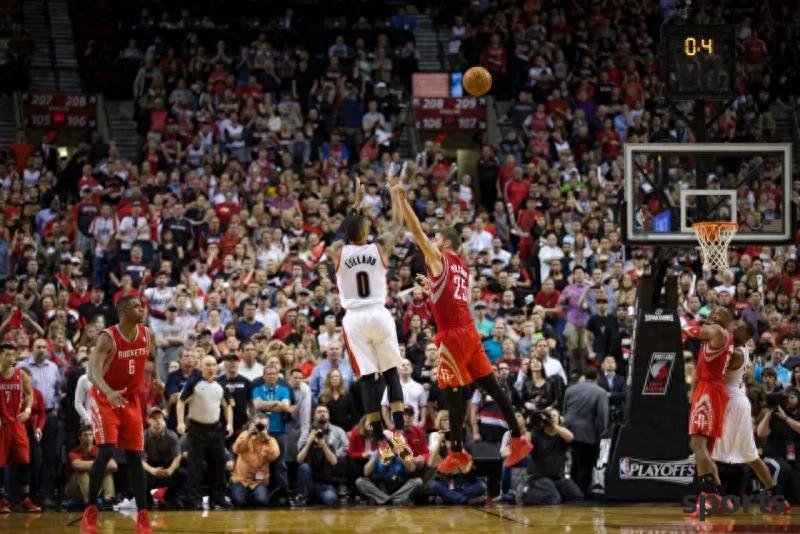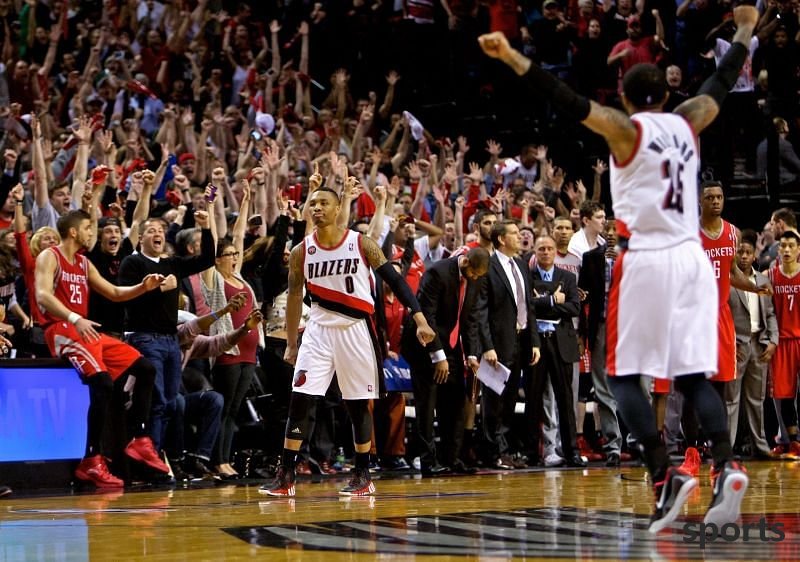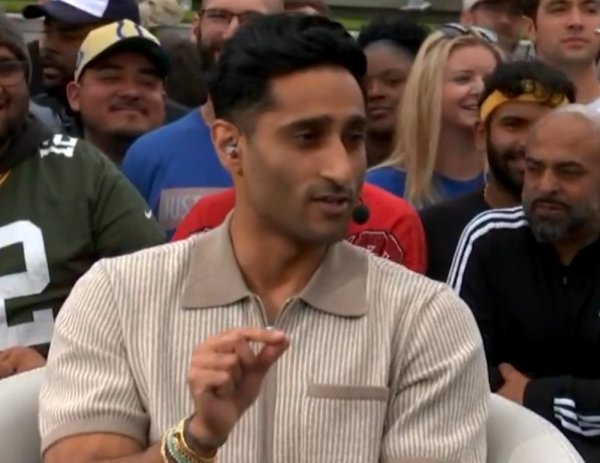HOME > Basketball
Looking back on the 10th anniversary: Lillard killed not only the Rockets, but also the basketball philosophy of an era?
5:56am, 14 May 2025【Basketball】
1. The final moment: historical freeze and destiny turn
On May 3, 2014, the sixth game of the first round of the NBA Western Conference playoffs, the Trail Blazers played against the Rockets at home. 0.9 seconds before the final game, the Rockets overtook the score with Parsons' tip-in, and seemed to have dragged the series into a tiebreak.
However, Lillard received a pass from Batum's sideline from the left three-point line, hit a buzzer-beating three-pointer against the defense, ending the game 99-98, and eliminating the Rockets out.

This decisive victory not only allowed the Trail Blazers to break through the first round of the playoffs for the first time since 2000, but also became Lillard's "devotion of the gods" in his career.
Today, ten years later, when we look back at this classic duel, we will find that it is not only a victory of personal heroism, but also a microcosm of tactical games, star competition and the collision of basketball philosophy of the times.
2. Tactical analysis: Trail Blazers' precision design vs Rockets' defensive loopholes
1. Trail Blazers' "multiple trap" tactics
The last 0.9 seconds of the sideline ball tactics can be regarded as textbook level:
Pull the right side: Lillard, Matthews and Williams are concentrated on the right side, forcing the Rockets' defense to shift their center of gravity.
Lillard's off-ball run: He used his teammate's cover to pop out from the right, used his speed to throw away Parsons, and received the ball 45 degrees on the left.
Multi-point contact: Aldridge formed the second catch point at the bottom corner, and Matthews and Williams ran back to the basket to attract defensive attention. The cleverness of this tactic is that it creates multiple potential end points through space cutting, and the Rockets failed to switch defenses in time due to communication errors, which eventually gave Lillard the opportunity to get an open space.
2. The Rockets' "single" dilemma
The Rockets' tactics relied too much on Howard's low-post singles, and the team only made 2 of 13 shots except Howard.
Although Howard scored 13 points in a single quarter, the Trail Blazers chose not to double-team and allowed them to play singles, which caused the outside players such as Harden and Jeremy Lin to feel cold. This "superstar dependence" is fully exposed at critical moments.
3. Star showdown: The winning and losing code behind the data
1. Lillard and Aldridge's "dual-core drive"
Lillard: Average of 25.5 points, 6.3 rebounds and 6.7 assists in the series, with a shooting percentage of 47%, especially the 25 points and a winning three-pointer of G6, showing a huge heart.
Aldridge: Average of 29.8 points, 11.2 rebounds and 2.7 blocks per game, and his dominant performance of 30 points and 10 rebounds in the first three quarters lays the foundation for the final victory.
The Trail Blazers have a combination of dual cores inside and outside, and have rich tactical levels, which has become the key to tearing the Rockets' defense line.
2. Harden and Howard's "highlights and regrets"
Harden: Averages 26.8 points and 5.8 assists per game, but his shooting percentage is only 37%. He made many attempts at critical moments, and was targeted by Lillard on the defensive end.
Howard: Averages 26 points, 13.7 rebounds and 2.8 blocks per game, with a shooting percentage of 55%, but he has become a "lonely hero" due to his singular tactics. The Rockets' "Morden Combination" data are gorgeous, but they fail to form effective chemical reactions, especially Harden's inefficiency is one of the reasons for failure.
4. Series background: Details of evenly matched wins
1. The slight difference in offense and defense efficiency
In the six series games, the two teams scored only 2 points apart (Trail Blazers 672-Rockets 670), which is one of the most stalemate first-round matchups in history.
But the Trail Blazers are better at handling key balls:
sideline ball success rate: G6 has two sideline ball tactics in the last moment (equals and final kills).
Role player contributions: Batum's pass, Matthews' defense, and Lopez's frame protection all became invisible winners and losers.
2. The Rockets' "Last quarter curse"
Throughout the season, the Rockets were known for their "Last quarter collapse". They even lost 54 points in the first half against the Thunder in the regular season. In the playoffs, this stubborn disease broke out again: in the fourth quarter of G6, all Rockets except Howard were silent, while the Trail Blazers completed the reversal through teamwork.
5. Historical Echoes: The inheritance of the ultimate kill and the significance of the times
1. The "Shexagram of Redemption" of the Trail Blazers in 2009, Roy won the Rockets in 0.8 seconds; in 2014, Lillard completed his revenge in almost the same way. The two winning games were five years apart, but they jointly wrote the history of grievances between the Trail Blazers and the Rockets.
2. The eve of the small ball era
2014 was a turning point in the NBA's tactical innovation. The Rockets are obsessed with Howard's low-level singles, while the Trail Blazers have begun to focus on space and three-pointers (38.2% of the three-point shooting percentage in the series vs. 32.1% of the Rockets). This showdown foreshadowed the collision between traditional insider styles and emerging outside dominant tactics, which gradually became the mainstream of the league.

3. The watershed of fate
Trail Blazers: Confidence soared after the final victory. Although he lost to the Spurs in the second round, Lillard officially joined the ranks of first-tier stars.
Rockets: The failure prompted management changes. Lawson was introduced in 2015 and the "magic ball theory" was created in 2017, but it never broke through to the Western Conference Finals.
6. Revelation: A modern mirror of classic battles
1. Team basketball victory: The Trail Blazers defeated superstars singles with diversified tactics, confirming that "basketball is a sport of five people."
2. Details determine success or failure: 0.9 seconds of tactical execution and a defensive communication mistake are enough to change the direction of the series.
3. The torrent of the times is irreversible: The Rockets' failure warns the team to follow the tactical trend rather than relying on outdated superstar models.
Conclusion
Ten years have passed, and Lillard's final victory is still talked about by fans. It is not only a moment of personal heroism, but also a testimony to basketball philosophy, teamwork and changes in the times.
For the Rockets, this is an unforgettable lesson; for the Trail Blazers, it is the starting point for regaining glory. In the long history of the NBA, such a classic battle will always shine.
Related Posts
- As expected! Reporters posted netizen prediction votes: 60% successfully predicted that James would not announce his retirement.
- A star who may retire in the NBA in the past five years. Time always says goodbye
- +1! The fourth player this summer goes abroad and joins the overseas league and is expected to become the next Yang Hansen
- Adebayo s girlfriend is too strong: He won 6 consecutive victories with 30+16, breaking the record and becoming the first person in WNBA history
- The Chinese men s basketball team will see a blowout talent in the next Olympics, and Yao Ming s dividends will gradually be reflected!
- NBA Rockets News: Renewal with Tate
- Wiggins takes a family on vacation and earns 250 million yuan. The Lakers want to trade him, and his wife has a good figure
- Heroes cherish each other! Pierce praised Kobe as the second Jordan, saying that defending him is very stressful
- NBA Playoffs: Unexpected 3-1, Kaiyong is in trouble, Nuggets Thunder King Mountain
- Chasing dreams and mocking Dillon was criticized by American netizens! James was caught in a gunfire!
Hot Posts
- As expected! Reporters posted netizen prediction votes: 60% successfully predicted that James would not announce his retirement.
- A star who may retire in the NBA in the past five years. Time always says goodbye
- +1! The fourth player this summer goes abroad and joins the overseas league and is expected to become the next Yang Hansen
- Adebayo s girlfriend is too strong: He won 6 consecutive victories with 30+16, breaking the record and becoming the first person in WNBA history
Recommend

The draft market has been rising all the way! US media strongly recommends the Hawks to choose Yang Hansen at the 22nd pick in the first round

Warriors News: Curry is recognized, Cole and his son join forces, and Kumingga works hard

After 3 games! The value of the men’s basketball top center has plummeted. He was once as famous as Yang Hansen!

Trae Young trains with Porter Jr. praises the latter: You can easily average 25+ in the new season!

Shams: This summer may become the craziest summer in history, and the management of each team is extremely looking forward to it

Not Jokic! Yang Hansen s template is more like Sabonis little!

How deep is the depth? Who is better in the Celtics against the Knicks?

The Bucks championship team fell apart! Daluo has 18 million shots from the Clippers in two years, and now only 2 people are left in the team